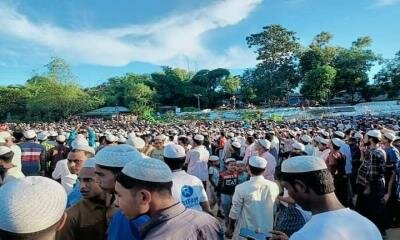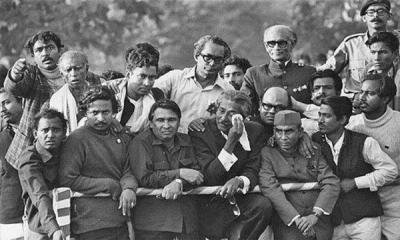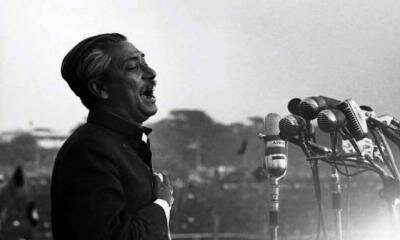Bangabandhu -- his struggle for emancipation of the peasantry
Cox Gazette | Shamsul Alam April 12, 2020, 03:38 AM

This article, devoted to Bangabandhu on the occasion of his birth centennial (Mujib Borsho), highlights an aspect of his life struggle towards emancipation of the peasants and peasantry who formed the largest segment of the populace (90 per cent) during his life time.
The aspect of Bangabandhu's life dedicated towards the emancipation of the peasants, landless farmers, share-croppers and wage labourers, in my understanding, has not drawn adequate attention of researchers, scholars and political commentators. This article sheds light on what Bangabandhu delivered to the farmers/to the peasantry by and large, and how he set the path of agricultural/rural transformation by institutional development.
When Bangabandhu returned home from Pakistani jail and took helm of the administration on January 10, 1972, war-ravaged Bangladesh was economically, infrastructurally, socially shattered. He found no organised bureaucracy, no cash to transact in Bangladesh Bank where notes were all burnt before Pakistani occupied forces surrendered. More than 10 million refugees started pouring back to the country. There was no food stock, no cattle stock to plough the lands, no seeds to sow. Thousands of arms were at the hands of freedom fighters at every nook and corners of the country while law-enforcement forces were not organised as yet. It's the Bangabandhu who very passionately and courageously tackled everything. Politically, within a very short period of three years and a half, the nation got a very well-crafted forward-looking and visionary constitution, Bangladesh became a UN member country, joined Non-Aligned Movement and the Organisation of Islamic Cooperation (OIC). Allied forces were withdrawn, arms from the freedom fighters were recovered, a general election was held. The nation was fortunate to have soon the first five-year plan with the aim to re-construct the war-ravaged economy. The Planning Commission was formed to prepare five-year plans within 19 days of Bangabandhu's home-coming. After independence in 1947 Planning Commission was formed in India in 1951 and in Pakistan, it took six years to form a Planning Commission in 1953.
With deft economic management Bangabandhu was leading the nation towards recovery and transformation. For the peasantry and agricultural sector he set a strong institutional foundation and took steps to ameliorate the problems of input shortage and recovering the transport system to develop an agricultural marketing system.
However, in the heightened cold-war era of international political groupings, Bangabandhu's domestic economic recovery efforts were not properly reflected in the western media and were often misconstrued by pro-western economists. Influentital diplomats and economists branded Bangladesh as a 'bottom-less basket' or 'basket case'. The World Bank in its first report on Bangladesh on September 25, 1972 observed that even in very favourable circumstances, it is very doubtful whether Bangladesh can prosper. Just Faland and J.R. Parkinson branded Bangladesh as a 'test case of development' connoting if Bangladesh can prosper than no other country will fail to prosper on earth.
Let's briefly review where Bangladesh is at present with its agricultural progress and diversification that led to a huge rural transformation. Our extreme poverty is now below 10 per cent and moderate poverty is around 18 per cent. The poverty rate in the mid-seventies was 84 per cent of total population. In 1972 our total rice production was 1.1 million metric ton which now stands at 38 million metric ton. In open water fish production Bangladesh now ranks third in the world. In poultry and egg production the country is self-sufficient. In goat production it ranks fourth in the world and in banana production, it is self-sufficient. We produce a couple of exotic fruits and in major fruits production we have gained unprecedented momentum. I am referring to all these because institutional set-ups were established during the Bangabandhu's time to act on.
The World Bank's first report on Bangladesh stated that 4.3 million houses were burnt during the war of liberation in 1972 and there was shortage of 3.0 million tons of food grains in the country. To rehabilitate the refugee's 1.0 million houses/shelters needed to be built immediately. Nine hundred colleges and six thousand high schools were destroyed and needed to be built to start educational activities. Mills and factories were also destroyed which needed rehabilitation. In those days, foreign experts opined that there would be famine and up to five million may die out of starvation. In 1972 Oxfam, World Bank and USAID also expressed concern about an ensuing famine. But that had not happened in 1972 or in 1973 because of massive relief work and improvement in transportation system including use of waterways. Famine though occurred in 1974 owing to devastating floods destroying both boro and aman crop in that year and stoppage of food aid under PL 480 on the plea that Bangladesh exported jute and jute goods to Cuba.
In 1972, Bangabandhu exempted payment of land tax up to 25 bigha and all agricultural loans of pre-liberation period were written off. The then government fixed the minimum prices for paddy, jute, sugarcane and tobacco. Rationing system was introduced for primary school teachers, landless and poor farmers. For low-income consumers Consumer Supply Corporation fair price out-lets were introduced through Trading Corporation of Bangladesh (TCB). Khas lands were distributed to landless farmers.
Mortgaged lands, if enjoyed for seven years by the mortgagee, must be returned to land owner without any compensation. Free text-books were distributed to primary school students. In the first budget of Tk 7.01 billion (701 core), Tk. 50 billion (500 core) was earmarked for rehabilitation and development. In the Tk 5.0 billion (500 core) development budget, Tk 1.0 billion (100 core) was earmarked for agricultural sector aimed to support production of essential agricultural products of 12 sectors of the first budget. Thus, agriculture sector got the highest allocation. In the first five year plan, Agriculture Ministry got the highest allocation of Tk 4.59 billion (459.10 core) followed by Ministry of Flood Control and Water resources of Tk 3.21 billion (321.20 core) which has linkage to crop productivity. Besides, Rural Development Ministry received Tk 1.5 billion (149.97 core) emphasising rural infrastructures.
In 1973 Bangabandhu's government provided Tk 1.0 billion (10 core) as loan to share-croppers and small farmers, distributed 50 thousand tons of fertilisers to farmers at subsidised prices, 2,125 mounds of Boro rice, 3 thousand mounds of wheat and 1700 maunds of potato seeds were distributed at very nominal prices to farmers.
The highest land ceiling for ownership was set to 100 bighas.
In 1972 Bangabandhu's government established Cotton Development Board. In 1973 was established Bangladesh Agricultural Research Council for coordination of all agricultural researches at Farmgate. Bangladesh Rice Research Institute and Bangladesh Institute of Agricultural Researches were reconstituted in 1972. Jute Research Institutes was established in 1972 and Bangladesh Institute of Nuclear Agriculture in 1975. Bangladesh Agricultural Development Corporation (BADC) was established to expand irrigation facility to farmers and help production of high-yielding variety seeds. To encourage agricultural extension services and research 'Bangabandhu prize' was introduced in 1973. Bangabandhu on February 13, 1973 made agricultural graduates at par with engineering and medical graduates in terms of salary, grade and rank which spurred agricultural extension, research and education resulting in far-reaching impacts on agricultural and rural transformation.
In agricultural productivity irrigation has an enormous impact. In 1973 Bangabandhu's government installed 20,000 power pumps and allowed rapid expansion of shallow and deep tubewells. Irrigated land area increased from 25,87,300 acres in 1971-72 to 35,61,472 acres in 1974-75.This rapid expansion of irrigated area bears the testimony how the Bangabandhu's government tried to revolutionise agricultural sector for the upliftment of peasants in rural Bangladesh who then comprised 90 per cent of the country's population. Agriculture got a big push technologically, institutionally resonating full political commitment of Bangabandhu towards the betterment of the conditions of the common masses. Bangabandhu emphatically said, 'this independence will go in vain, if people of this Bangla cannot have stomach-full food, independence will remain unfulfilled if mothers and sisters do not get adequate clothing, this independence will remain unfulfilled if the youths of this country do not get jobs or remain unemployed'. Bangabandhu also stated 'fundamentally we want to have an exploitation-free society, we want to have a socialist economy but the system will be ours. We do not like to import it from anywhere in the world'.
With Bangabandhu's brutal assassination, the nation was thrown into wilderness and lost momentum of development for continuous two decades to 1995.
Prime Minister Sheikh Hasina, a visionary statesman, now bears the torch of Bangabandhu for transformation and development of the country with firm commitment for agricultural modernisation and development to a full-blown commercial agriculture befitting a developed nation that she aspires to be attained by 2041.
Prof. Shamsul Alam is Member (Senior Secretary), General Economics Division, Bangladesh Planning Commission
More News from Freedom Fighter
-

Internet access will no longer be blocked in Ukraine says Elon Musk
-

No possibility of US sanctions expansion: Shahriar
-

UNHCR and IOM Condemn Deadly Attack on Displacement Site in DR Congo
-

Teleworking during COVID: Risks, benefits and steps to a ‘new normal’
-

Army officer among 4 dead in Bandarban gunfight
-

Health tech startup Best Aid raises investment from YY ventures.
-

DiCaprio praises Bangladesh on new marine protected area around St Martin`s
-

Guterres calls for end to conflict in Ethiopia after deadly attacks
-

Rohingya refugee camps hit by second fire in 10 days ,Leaving thousands homeless
-

BNCA begins a shadow investigation into elephant killing in Cox’s Bazar
-

One more elephant found dead in Cox`s Bazar, death toll 7 in 11 days
-

Shahriar Nisan joins BDMORNING as Acting Editor
-

Two more Rohingya men arrested over Mohib Ullah killing
-

One arrested over Rohingya leader Muhib Ullah killing.
-

Hundred Plus UN Job Openings in a glance
-

Youth empowerment for tourism’s future ,The eight winning solutions
-

UN Refugee agency condemns killing of Rohingya refugee leader
-

Thousands of `Rohingya Refugees` pay their last respects to Mohib Ullah
-

Rohingya Leader Mohibullah Killed in Cox`s Bazar camp
-

Internet connection cuts off in more than ` 25 `townships in northwestern Myanmar





-20200411213251.jpg)

Write Your Opinion :